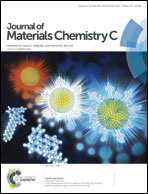Light-driven fluorescence enhancement and self-assembled structural evolution of an azobenzene derivative†
Abstract
Producing a fluorescent azobenzene derivative and investigating the relationship between the self-assembled structure and photophysical properties is a challenging topic, which is of significance in material science. Here, we report the light-driven fluorescence enhancement and self-assembled structural characteristics of an azobenzene derivative N-(3,4,5-octanoxyphenyl)-N′-4-[(4-hydroxyphenyl)azophenyl]1,3,4-oxadiazole (AOB-t8). A highly fluorescent self-assembled aggregate of cis-AOB-t8 in organic solution under UV light illumination has been observed; the quantum yield can reach 33.7 × 10−2, which is an enhancement of about 306 times compared with that of trans-AOB-t8, which is negligibly fluorescent in the initial nonirradiated solution. It has been proposed that the fluorescence enhancement originates from the trans-to-cis monomeric isomerization and the aggregation of cis-AOB-t8. Based on the theoretical calculations, we have discussed the mechanism for light-driven fluorescence enhancement of the monomeric cis-AOB-t8, which was commendably applied to interpret the observed spectroscopic result. In addition, the formation of the J-aggregate of cis-AOB-t8 leads to further enhancement of the emission. Moreover, this photocontrolled fluorescence enhancement in a concentrated solution (1 × 10−3 M) could be attributed to the significant structural changes of the aggregates, from fiber-like aggregates to layer structured aggregates. According to the spectroscopy study, it is suggested that the trans-AOB-t8 is inclined to form H-aggregates and the cis-AOB-t8 forms J-aggregates, which could probably lead to the structural variety related to the different molecular conformations of AOB-t8.


 Please wait while we load your content...
Please wait while we load your content...